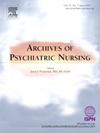Efficacy and safety evaluation of olanzapine treatment for schizophrenia patients: A retrospective data analysis
IF 2.2
4区 医学
Q1 NURSING
引用次数: 0
Abstract
Objective
This study aimed to comprehensively evaluate the efficacy and safety of olanzapine in the treatment of individuals with schizophrenia.
Methods
A retrospective study was conducted on 150 individuals with schizophrenia treated with olanzapine at a tertiary psychiatric hospital from January 2015 to December 2020. The efficacy was assessed using the Positive and Negative Syndrome Scale (PANSS), Clinical Global Impression-Severity (CGI-S), Personal and Social Performance (PSP) scale, and Brief Psychiatric Rating Scale (BPRS). Safety was evaluated based on the incidence of adverse events. Data were analyzed using descriptive statistics, paired t-tests, chi-square tests, and multiple regression analysis.
Results
The mean PANSS total score significantly decreased from 92.3 ± 13.8 at baseline to 56.9 ± 11.5 after 12 weeks of treatment (p < 0.001). Significant improvements were observed in positive symptoms, negative symptoms, and general psychopathology subscales (p < 0.001). CGI-S, PSP, and BPRS scores also demonstrated significant enhancements in overall clinical status, social functioning, and psychiatric symptoms (p < 0.001). The most common adverse events were weight gain (28 %), somnolence (22 %), dizziness (18 %), and dry mouth (15 %). Mild elevations in metabolic parameters were observed. The incidence of EPS was low (6 %), and prolactin levels increased mildly. Higher baseline symptom severity and younger age as predictors of greater improvement in PANSS scores (p < 0.01).
Conclusions
Olanzapine demonstrated significant efficacy in reducing a wide range of schizophrenia symptoms, improving clinical status, enhancing social functioning, and alleviating overall psychiatric symptoms. The safety profile was generally manageable, with mild to moderate adverse events.
求助全文
约1分钟内获得全文
求助全文
来源期刊
CiteScore
3.70
自引率
0.00%
发文量
131
审稿时长
160 days
期刊介绍:
Archives of Psychiatric Nursing disseminates original, peer-reviewed research that is of interest to psychiatric and mental health care nurses. The field is considered in its broadest perspective, including theory, practice and research applications related to all ages, special populations, settings, and interdisciplinary collaborations in both the public and private sectors. Through critical study, expositions, and review of practice, Archives of Psychiatric Nursing is a medium for clinical scholarship to provide theoretical linkages among diverse areas of practice.

 求助内容:
求助内容: 应助结果提醒方式:
应助结果提醒方式:


